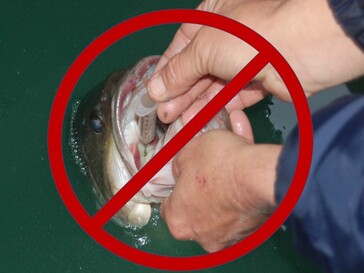Black Bass Fizzing/Barotrauma Relief Information

DO NOT FIZ THRU THE MOUTH!!!
NEVER EVER EVER!!!!
You certainly can reach the swimbladder thru the mouth.
BUT - you also put holes in a lot of other organs that Should not have holes in them!! It doesn't always kill a fish immediately ( the loyal mouth fizzers AWAYS tell me they've "never killed a fish" (that died instantly in their tank anyway) Just be cause you don't SEE it happen - doesn't mean it doesn't happen. There are controlled, scientific studies that have proven fizzing through the mouth is harmful. And other studies have proven the survival of fish treated with side fizzing is increased over mouth fizzing or doing nothing at all.
It is the way everyone used to fizz fish - because we knew no other way. Researchers valiantly worked and found a better way! They looked for a better way because it was known that fizzing thru the mouth caused enhanced mortality by itself. SO - they devised a way to reach the swim bladder - by going through the side of the fish - piercing only skin/muscle/swim bladder.
MORAL OF THE STORY --> FIZZ YOUR FISH - FIZZ THEM THRU THE SIDE - FIZZ THEM AS SOON AS YOU SEE
SIGNS OF BAROTRAUMA - AS SOON AFTER CATCHING/LANDING THE FISH THAT YOU CAN. PERIOD.
THEORY :
Barotrauma Relief (or "fizzing", as it is commonly referred to) is a technique that remedies swim bladder over-inflation that results from bringing a fish up to the surface from the pressures in which they are are used to living. To get a better understanding of the swim bladder gas (think air filled balloon) and how the pressure acts on the swim bladder, conduct an experiment next time you are swimming in a pool or lake. Grab a balloon, blow it up, and tie it off. Get an idea of the size of the balloon by seeing how far around the balloon yoyr hands will go. NOW - jump into the water with the balloon and dive down as far as you comfortably can. STOP. Hold the balloon out in front of you and compare the size of the balloon under the under column to the size the balloon was above the water.
The balloon will be MUCH smaller. The decrease in size will be dependent on how much water is above the balloon. That water column above the balloon has weight, and the weight of that water applies PRESSURE to all surfaces of that balloon - compressing the contents of the balloon (the contents being the molecules of air!). All gasses are very compressible. For you mechanics out there - think about a gas suspension cylinder. The gas is compressed and absorbs the shock..
The swim bladder process actually works in reverse. The fish starts with a swim bladder down under the depths of the water, applying pressure to the gas in the swim bladder and COMPRESSING the gas/swim bladder to the 'normal' smaller size that fits nicely within the fish's body. As you crank that fish up from the depths on the end of your line, there is less and less water covering that fish and it's swim bladder. This equates to less and less weight, which translates to less and less pressure. This decrease in pressure allows the gas molecules to expand quickly, stretching the swim bladder 2-3 times its size (depending on the depth the fish was recently in).
Think of someone slipping a balloon into YOUR abdomen and blowing it up -it would be VERY uncomfortable. And, it would cause damage - bruising to the immediate organs/compressing the heart so it cannot fill properly to pump oxygenated blood thru the blood vessels. So even if your livewells are sufficiently oxygenated, the fish's heart cannot move the blood. The blood cannot move, which means it can't carry blood to the tissues to feed tissues oxygen. It also cannot carry waste products (CO2, etc) away. This results in serious acidosis and a downward spiral in the condition of the fish. So much so that even if the fish is alive at weigh in, the tissues are so damaged the fish cannot recover due to the exhaustion and acidosis of the blood and tissues. Sadly, post tournament mortality is inevitable for most of these fish.
Our tournament mantra for the last 45 or so years has been catch and release. Releasing a LIVE fish.
But I feel we have more of a responsibility that to just release fish that are simply 'alive'. The term ALIVE covers a very wide range of conditions. From a healthy fish to a fish that is just one fin-wave away from death. I feel we owe our resource a lot more than just releasing a fish that is 'alive'. I think we need to hold our tournaments to higher standards. When you are caring for your fish, think more along the term of keeping your fish VIABLE. Being 'viable' has a whole different implication/meaning. VIABILITY means a fish will be released to eat, grow, and REPRODUCE/replace itself in the ecosystem, thus replenishing the resource for future anglers to enjoy.
This is a critical distinction. Our natural resources have finite limitations- there are only so many gallons of water in each pond/lake that will only support so many fish. On the other hand, human population continues to expand and expand. The increased pressures put on our natural resources (due to increased angling pressure from more people/water quality issues from increasing pollutants from the increased population/increasing climatic extremes) makes sustaining the resource population a bigger challenge every day.
If you are a tournament angler - PLEASE do your part. Be responsible for the release of VIABLE fish back into the ecosystem. Your children and grandchildren will thank you.
FIZZING RESOURCES :
(FOR LGM SPECIFICALLY)
https://video.bassmaster.com/detail/videos/conservation/video/5522492441001/how-and-where-to-fizz-largemouth-bass?autoStart=true